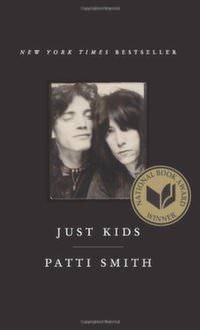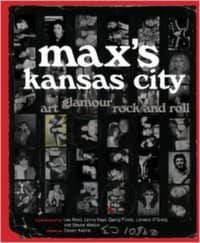 Just Kids, a memoir by artist and musician Patti Smith, is a touching glimpse into one of the most endearing relationships ever seen on the page. Throughout the book, the strong bond between Smith and photographer Robert Mapplethorpe is evident; the relationship guiding and dividing both of their lives in complicated ways. Early in the book, before Smith or Mapplethorpe find fame, the young couple walks through Washington Square Park, dressed in beatnik sandals and love beads. An older couple notices them and starts to take their picture.
Just Kids, a memoir by artist and musician Patti Smith, is a touching glimpse into one of the most endearing relationships ever seen on the page. Throughout the book, the strong bond between Smith and photographer Robert Mapplethorpe is evident; the relationship guiding and dividing both of their lives in complicated ways. Early in the book, before Smith or Mapplethorpe find fame, the young couple walks through Washington Square Park, dressed in beatnik sandals and love beads. An older couple notices them and starts to take their picture.
“Oh, take their picture,” said the woman to her bemused husband. “I think they’re artists.”
“Oh, go on,” he shrugged. “They’re just kids.”
The event is an ironic foreshadowing and the universal theme throughout the book: the idea that many of the famous people that Smith and Mapplethorpe encounter are really just kids; vulnerable artists, many of them in their 20s, who are later plagued by the tumultuousness of the times. These are the “kids” at the center of their incendiary generation. This universal trait reveals insecurities in many, which Smith notices in a poignant moment with Janis Joplin:
“I took Janis back to her room and sat with her while she bemoaned her fate. Before I left I told her that I’d made a little song for her, and sang it to her…As I was leaving, she looked in the mirror, adjusting her boas.
“How do I look man?”
“Like a pearl.” I answered. “A pearl of a girl.”
 Although Smith and Mapplethorpe’s relationship is the main focus of the book, it is really the places that they go and the people that they meet along the way that illuminate their journey. The reader watches them come into their own when they live in the infamous Chelsea Hotel, a place where artists, writers, and musicians alike live and create side by side. It is an electric atmosphere and Smith and Mapplethorpe’s creative lives expand and thrive here. In many chapters they frequent the restaurant adjoined to the Chelsea Hotel, the El Quixote, where they eat paella and spicy green sauce, surrounded by rock stars like Grace Slick. Mapplethorpe wants to immerse himself into the “who’s who” of famous artists and Smith begins to feel a kinship with the artists around her, but she is never as concerned with fitting in.
Although Smith and Mapplethorpe’s relationship is the main focus of the book, it is really the places that they go and the people that they meet along the way that illuminate their journey. The reader watches them come into their own when they live in the infamous Chelsea Hotel, a place where artists, writers, and musicians alike live and create side by side. It is an electric atmosphere and Smith and Mapplethorpe’s creative lives expand and thrive here. In many chapters they frequent the restaurant adjoined to the Chelsea Hotel, the El Quixote, where they eat paella and spicy green sauce, surrounded by rock stars like Grace Slick. Mapplethorpe wants to immerse himself into the “who’s who” of famous artists and Smith begins to feel a kinship with the artists around her, but she is never as concerned with fitting in.
One of the places to be is Max’s Kansas City, a popular hangout in New York City. Max’s, owned by Mickey Ruskin, an artist friendly individual, offers a free cocktail hour buffet including Buffalo wings, and is said to keep many a struggling artist and drag queen alive. The interior of the place is casual, the walls covered with pieces of abstract art given to Mickey by artists who ran up bar tabs they could never pay off.
 If you went to Max’s on any given night you might see Janis Joplin, Salvador Dali, Bob Dylan or Jim Morrison seated beside Andy Warhol, Edie Sedgwick and the Factory Girls, while The Velvet Underground played upstairs. What makes Smith’s account so authentic is that she is often on the outside looking in, not quite part of the scene but on the cusp…always teetering on the edge. She respects her fellow artists, but she is rarely star struck.
If you went to Max’s on any given night you might see Janis Joplin, Salvador Dali, Bob Dylan or Jim Morrison seated beside Andy Warhol, Edie Sedgwick and the Factory Girls, while The Velvet Underground played upstairs. What makes Smith’s account so authentic is that she is often on the outside looking in, not quite part of the scene but on the cusp…always teetering on the edge. She respects her fellow artists, but she is rarely star struck.
 The first time she visits Max’s Kansas City Andy Warhol isn’t there and hasn’t been for quite some time. Smith and Mapplethorpe miss the epicenter of the scene by a few weeks. They awkwardly eat a salad in the corner as the regulars wander about, throwing hard, inedible chickpeas at each other—a staple at Max’s Kansas City. Smith is eventually accepted into the crowd, but she never feels like she belongs.
The first time she visits Max’s Kansas City Andy Warhol isn’t there and hasn’t been for quite some time. Smith and Mapplethorpe miss the epicenter of the scene by a few weeks. They awkwardly eat a salad in the corner as the regulars wander about, throwing hard, inedible chickpeas at each other—a staple at Max’s Kansas City. Smith is eventually accepted into the crowd, but she never feels like she belongs.
The defining characteristic about these burgeoning artists is that they are young and struggling to make something of themselves, completely engulfed by the cultural scene around them. The vulnerability of youth could either make you or break you as an artist.
 In one memorable moment, Mapplethorpe hustles on the street to make their rent, an idea spurred on by curiosity and the romance of Midnight Cowboy, while Smith stays home, obviously distraught. Although Smith understands the often-dangerous experimentation of the artist (and Mapplethorpe’s understandable anxiety over their financial future) perhaps it is her slightly removed existence from the scene that allows her to see past their present troubles. Smith successfully makes a name for herself by creating works inspired by the beauty of youth; but she never lets the vulnerability of youth destroy her. She is a true artist who can find the balance between the two, while Mapplethorpe is not quite so lucky. After all, as she eloquently states: “Who can know the heart of youth but youth itself?”
In one memorable moment, Mapplethorpe hustles on the street to make their rent, an idea spurred on by curiosity and the romance of Midnight Cowboy, while Smith stays home, obviously distraught. Although Smith understands the often-dangerous experimentation of the artist (and Mapplethorpe’s understandable anxiety over their financial future) perhaps it is her slightly removed existence from the scene that allows her to see past their present troubles. Smith successfully makes a name for herself by creating works inspired by the beauty of youth; but she never lets the vulnerability of youth destroy her. She is a true artist who can find the balance between the two, while Mapplethorpe is not quite so lucky. After all, as she eloquently states: “Who can know the heart of youth but youth itself?”
Image Credits:
Cover Photo: http://sexualityinart.wordpress.com/2007/01/11/mapplethorpe-1-of-3/
Midnight Cowboy poster: https://en.wikipedia.org/wiki/Midnight_Cowboy



